When developing your garden, every gardener wants to choose the best plant for their garden. Choosing from so many options from the local nursery can be overwhelming, especially when you need flowers to stand up to the Georgia heat.
Due to Georgia’s hot and humid climate, some flowers may suffer to survive there, and some will thrive in such conditions.
If you struggle to find the right flowers for your flower garden, we are here to help you. Being mindful while choosing the right flowers is necessary to avoid any issues in the future.
Below we have put together the flowers you can plant in your Georgia flower garden without any second thoughts.
Baby’s breath
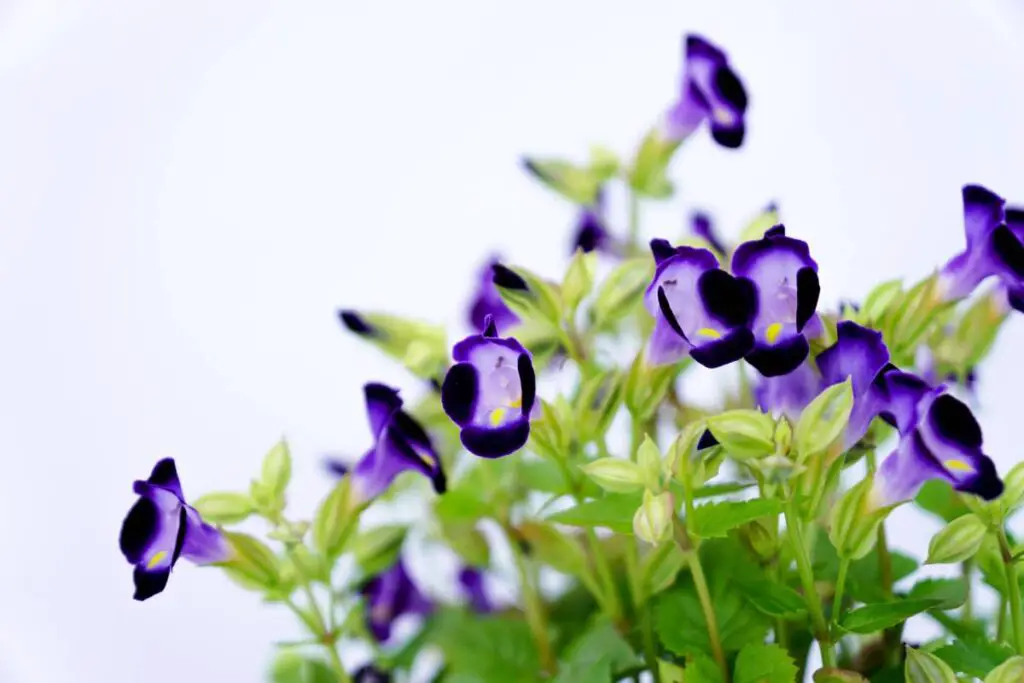
Baby’s breath has more than 100 species with a variety of looks. They produce five-petaled flowers in white or pink, attracting bees and butterflies. It proliferates and is considered invasive in some parts. They are highly toxic to humans and pets. They are low maintenance and will survive most conditions by themselves.
You’ll typically only need to water during dry spells and feed annually. Once your plants mature, you might need to support them, such as garden stakes, to prevent the thin stems from flopping over. You also can proactively install stakes when planting so that the baby’s breath can grow around.
Sunlight: Baby’s breath grows best in direct sunlight. They will not mind some shade, especially during extreme temperatures. Ensure good sunlight to avoid leggy growth and fewer flowers.
Watering: Baby’s breath does not demand much attention in case of watering. They need moist soil when young, mature plants don’t need water until a long drought. Avoid over-watering as it can result in root rot and even kill the plant.
Fertilizer: Baby’s breath will survive without any food. Too much feeding can lead to a floppy and leggy plant. Simply adding compost to the soil every spring is sufficient.
General care: Baby’s breath can withstand a variety of temperatures. They prefer dry climates and, in high humidity, ensure excellent drainage. Remove spent flowers and prune after the first flowering to promote blooming.
Begonia
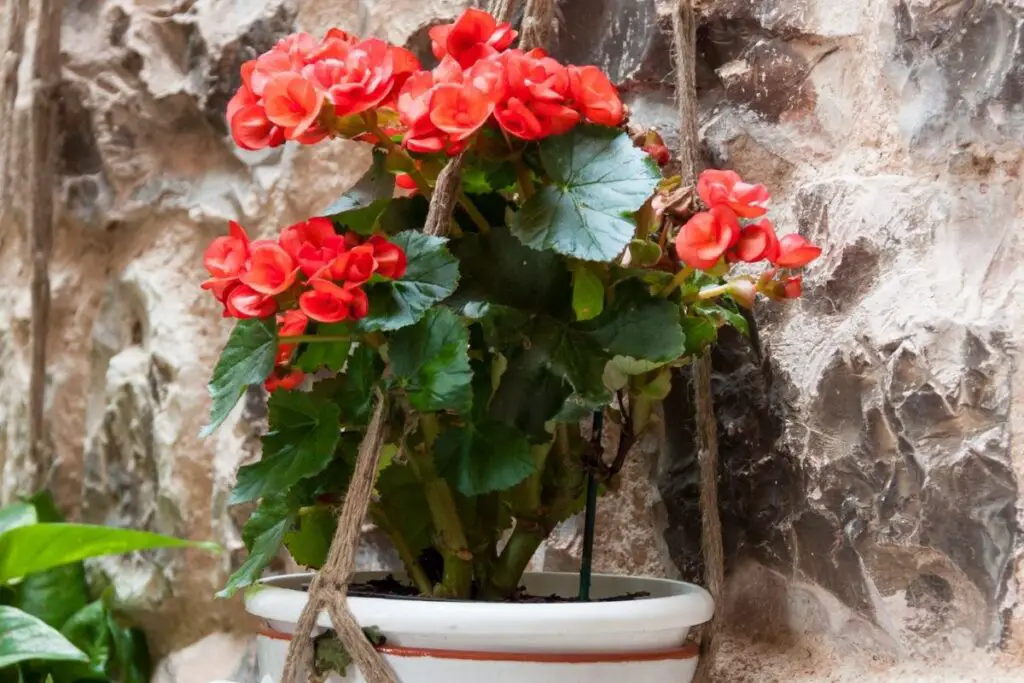
Begonias are grown for their lovely flowers. The best plant to buy is one with unopened, healthy buds. The plant produces beautiful blooms in bright red, pink, yellow, white, etc. They will fill your garden in the winter season.
Sunlight: Begonias enjoys bright, indirect sunlight on most days. They need light to bloom as they are photoperiod bloomers.
Watering: Water your begonias at regular intervals. Ensure the soil is halfway dry before the next watering. Make sure the excess watering is draining correctly.
Fertilizer: Feed begonias with liquid fertilizer weekly by diluting it to half the strength. During fall, use high-phosphorus fertilizer to stimulate blooms.
General care: Begonias require warm and humid temperatures. Keep pinching the flowers to encourage new blooms. Cut back the plant after blooming and let it dry out. Then water it when the temperature goes up.
Bugleweed
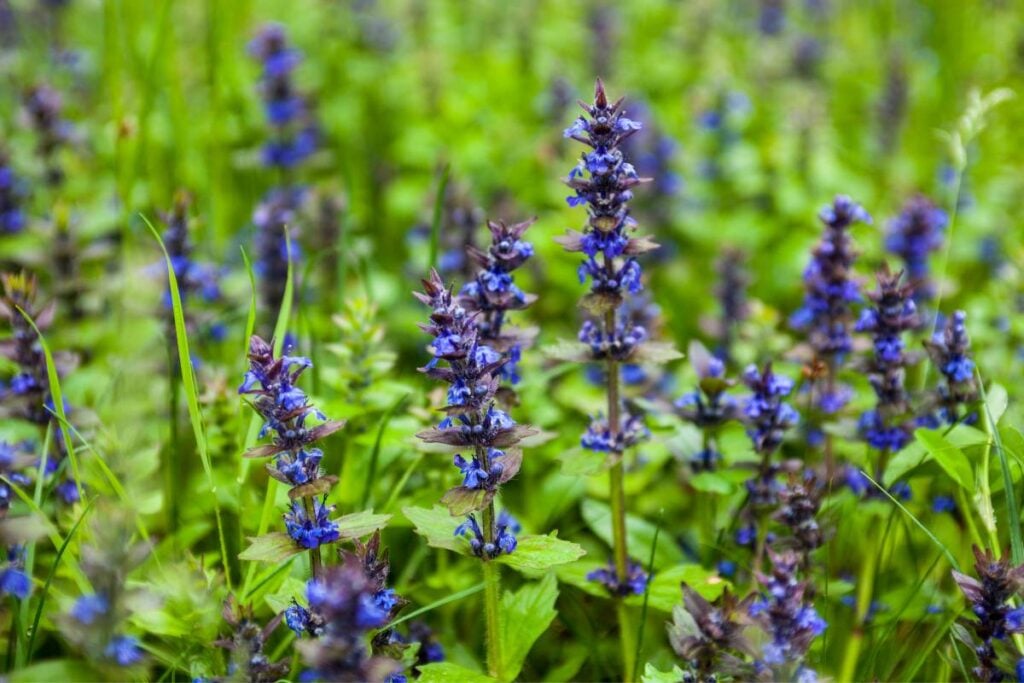
Bugleweed is a great choice to grow in Georgia. Its glossy dark green variegated foliage and elegant flower spikes add to the beauty of the space. Their blue, purple, and violet flowers bloom mid to late spring, stretching up to 10 inches tall. It spreads aggressively and needs to be planted where it doesn’t creep. Its roots also help in preventing soil loss.
Sunlight: Bugleweed will be happily growing in full sun to partial shade. Its foliage will be most vibrant if it receives 3-4 hours of daylight daily.
Watering: Bugleweed, when young, appreciates weekly watering to establish strong roots. Established plants become drought tolerant but would still appreciate weekly watering. The right time to water bugleweed is when its top few inches are dry.
Fertilizer: Bugleweed will demand to feed only when growing in inferior soil. Use an all-purpose fertilizer or water-soluble fertilizer by diluting it. Avoid overfeeding, as it can result in leggy growth.
General care: Bugleweed is a hardy plant that can withstand various temperatures. In hot and humid climates, it needs good airflow to prevent crown rot. Prune the plant to control its size—also, little flower spikes in late summer after the blossoms have withered.
Lenten rose
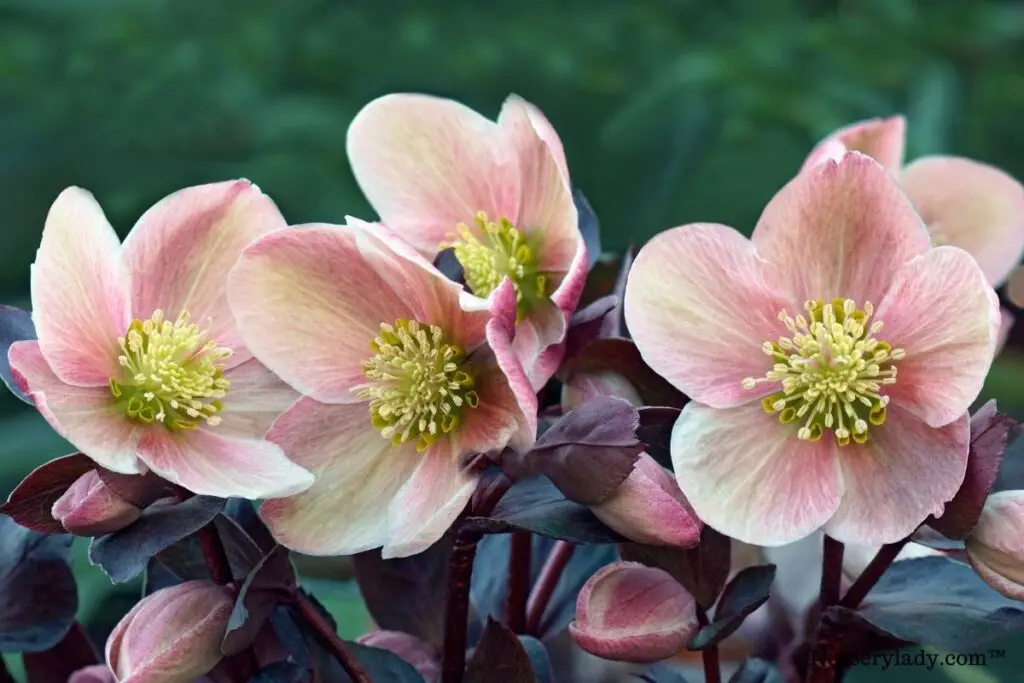
Lenten rose, not a rose, is a hybrid hellebore. Its traditional colored blooms, from white to pink and leathery foliage add that conventional beauty to the garden. With time, many cultivars produce more colors like dark purple, yellow, cream, maroon, etc. The blooms may be upward-facing or downward facing depending on the variety. It grows slowly from seeds and matures into flowering in 2-3 years. It is easy to develop and tolerate various conditions once established; what more do we want?
Sunlight: Lenten rose will bloom in the shade, with sepals and foliage retaining its vibrant colors. However, allow some light to pour in during winter. It will perform best in full to partial shade.
Watering: Lenten rose will be happier in evenly moist soil but does not promote constant wet conditions. During hot and dry climates, keep the plant well watered, but it can withstand dry conditions once established.
Fertilizer: When grown in containers, Lenten rose requires some organic matter monthly. When grown in a cluster, you must fertilize it with a slow-release fertilizer in late winter to promote new foliage growth. If using liquid fertilizer, avoid splashing on the leaves, as it can burn their leaves.
General care: Lenten rose likes a warm climate and must be protected in winter. Its foliage can become scorched in shallow temperatures. If the sun is intense, consider casting shade or planting near trees to protect the plant from the hot sun.
Looking for gardening supplies? We have tested 100's of products before recommending them to you guys. Check out our best pick below:
| Image | Gardening Supplies | Best Price? |
|---|---|---|
 Top
Top Top
Top | Raised Garden Bed Kit | Check On Amazon |
 | XLUX Soil Moisture Meter, Plant Water Monitor, Soil Hygrometer Sensor for Gardening, Farming, Indoor and Outdoor Plants, No Batteries Required | No Results |
 Top
Top Top
Top | 82 Pcs Garden Tools Set and Extra Succulent Tools Set | Check On Amazon |
 | Joeys Garden Expandable Garden Hose with 8 Function Hose Nozzle, Lightweight Anti-Kink Flexible Garden Hoses, Extra Strength Fabric with Double Latex Core, (50 FT, Black) | No Results |
 Top
Top Top
Top | Dual Chamber Compost Tumbler | Check On Amazon |
 Top
Top Top
Top | Sunnyglade Plant Stakes | Check On Amazon |
 Top
Top Top
Top | Organic Cold Pressed Neem Seed Oil | Check On Amazon |
 Top
Top Top
Top | Mighty Mint Gallon :-Insect and Pest Control Peppermint Oil | Check On Amazon |
 Top
Top Top
Top | Scotts DiseaseEx Lawn Fungicide | Check On Amazon |
 Top
Top Top
Top | Jacks Classic 20-20-20 All Purpose Fertilizer | Check On Amazon |
 Top
Top Top
Top | 30,000 Seeds Pollinator Attracting Wildflower Mixture | Check On Amazon |
 Top
Top Top
Top | Survival Vegetable Seeds Garden Kit-Over 16,000 Seeds | Check On Amazon |
Cockscomb
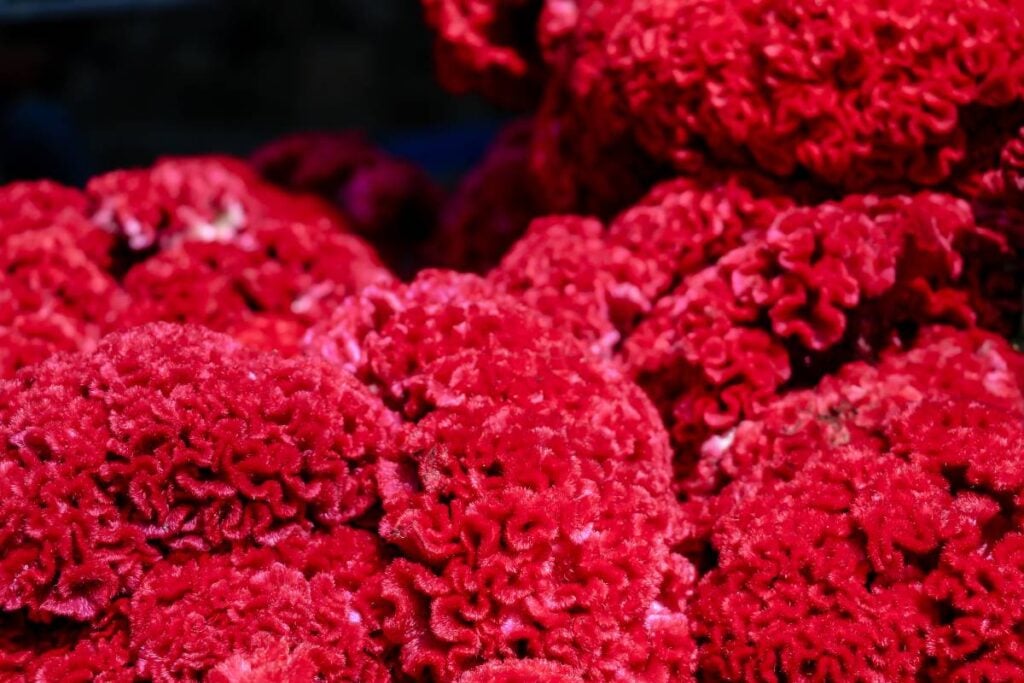
Cockscomb got its name due to its unique resemblance to the comb on a rooster. The green or bronze leaves and red, yellow, white, or pink velvety flowers make a beautiful addition to your garden. Its flowers, even when dried, keep their colors and can be added to different dried flower arrangements. It is also resistant to most diseases and pests.
Sunlight: Cockscomb will be happier in both full sun and partial shade. In partial shade, check their moisture, as too much water can lead to rot, fungus, etc. The best location is where it can receive 8 hours of sunlight.
Watering: Watering right is essential for cockscomb to stay healthy. Keep its soil evenly moist but avoid over-watering. Water only when the top few inches of the soil are dry. Do not water from the top, as it can cause leaf-related issues.
Fertilizer: Amend soil with compost while planting cockscomb. This will fulfill the plant’s nutrient needs and make the soil light. The monthly application of liquid fertilizer during the growing season is appreciated.
General care: Cockscomb prefers warm temperatures. It can be grown annually in cold winters too. This plant can thrive in both low and high humidity.
Common yarrow
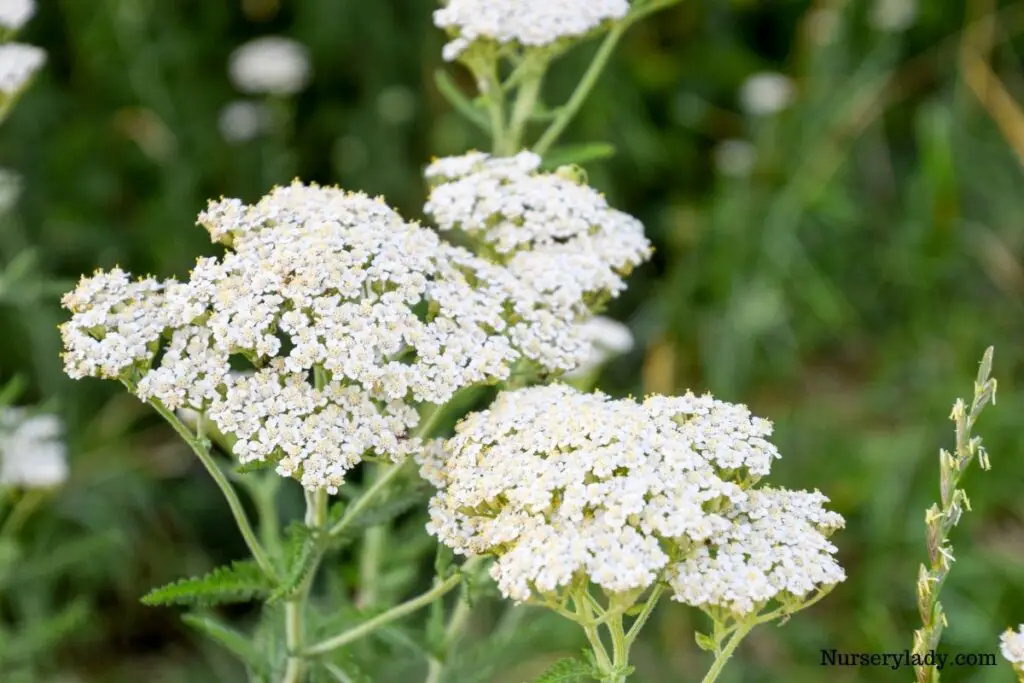
Common yarrow has feathery-shaped aromatic leaves in white. It can attain a height of 3 feet or more. It is considered toxic to dogs, cats, and horses. It is hardy, and once established, it will flourish in unfavorable conditions too.
Sunlight: Common yarrow prefers a spot where it can receive full sunlight on most days. If less light is available, the plant will still grow but become leggy and thin.
Watering: When grown from seeds, common yarrow needs frequent watering to mature. Mature ones will be happy with occasional waterings and are drought tolerant. During rainfall, altogether avoid watering common arrows.
General care: Common yarrow grows best in warm temperatures between 65°F to 75°F. Though in hot summer, when the temperature rises above 86°F, the plant may suffer from heat damage. Also, avoid exposing the plant to cold drafts and protect it in freezing temperatures. Regular pruning and deadheading are mandatory for continued blooming.
Fertilizer: Common yarrow appreciates the side-dressing of compost once in the spring. However, you can avoid feeding significantly when the plant grows in a rich soil medium.
Daylily
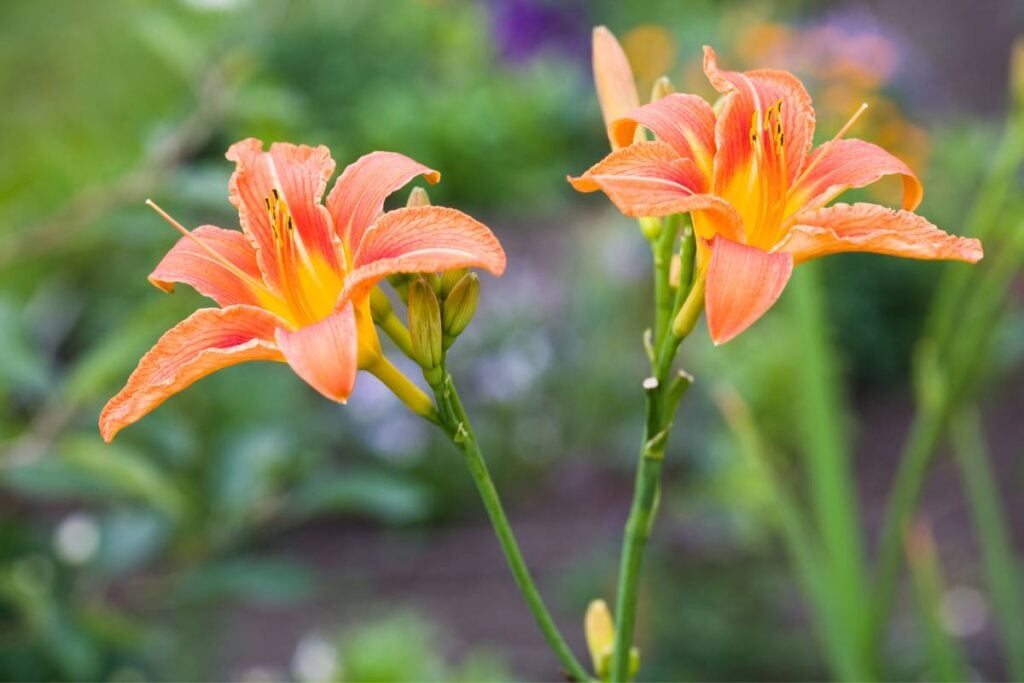
Daylily, a prevalent and loved plant, looks impressive in borders, edges, etc. Its beautiful colors will come in spring to late summer. It is an easy-growing plant and perfect for novice gardeners. It will keep your garden loaded with bees, butterflies, and hummingbirds. Spring is the best time to plant daylily to establish strong roots in summer.
Sunlight: Daylily is a sun-loving plant and appreciates direct sun daily. During hot summer, you can compensate for the intense sun by providing the plant with some shade. To retain dark varieties, keep the plant in full sun in a hot climate.
Watering: Daylilies only need steady watering in the first growing season. After that, they become drought tolerant and hardly ask for water. Mulching can retain moisture and act as a protective layer in cold temperatures.
Fertilizer: Being a tolerant plant, daylilies do not need food to grow. You can add compost once in the growing season to amend the soil with needed nutrients.
General care: Daylilies can withstand most climate conditions and humidity levels. Remove yellow leaves to encourage new leaf growth. Also, remove seed capsules when you see them saving plants energy to produce blooms.
Foxglove
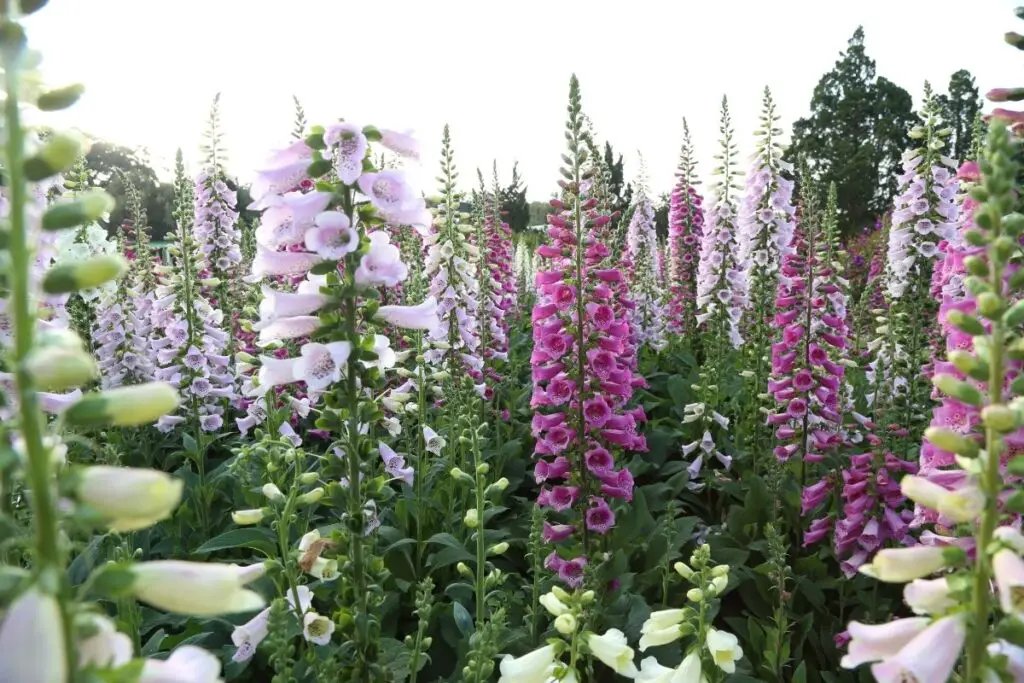
Foxglove is a quintessential plant featuring tubular flowers with speckles on them. It multiplies and will flower in its second season. It is highly toxic to humans and pets; almost all parts of the plant are poisonous. Stake the taller varieties to prevent the plant from flopping.
Sunlight: Foxglove flourishes in direct sun and will grow in partial shade too. Provide the plant with some shade during hot summer afternoons.
Watering: Foxglove likes slightly moist soil, but soaking it can lead to rot. Ensure proper drainage to avoid root rot, fungal diseases, etc. During summer, water the plant deeply once a week.
Fertilizer: Foxglove is happy with an inch layer of mulching. When germinating in rich soil, fertilizing is unnecessary, and too much feeding can harm flower production. If the soil medium is poor, add a slow-release fertilizer in the early spring.
General care: Foxglove prefers cool temperatures and can withstand high temperatures up to 90°F. It can tolerate all humidity levels, although good airflow is required in excess humidity. Deadhead, the flower spikes for a second flowering period.
Globe amaranth
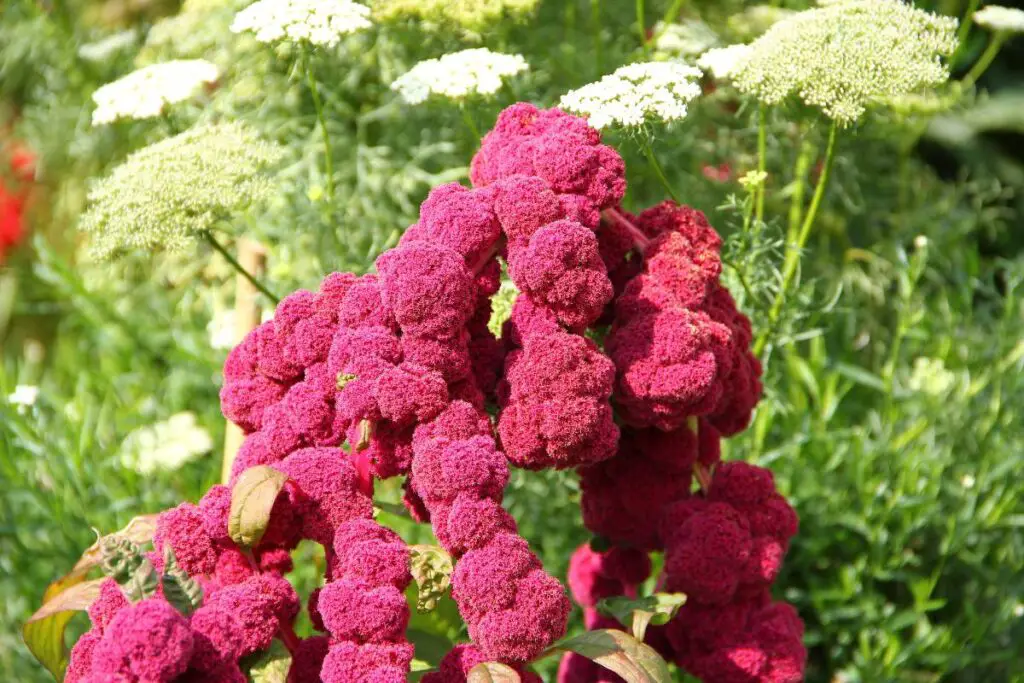
Globe amaranth is easy to grow, fast-growing, and matures rapidly. It features attractive bracts from June to frost, drawing bees and butterflies. You can plant it from seeds in the late winter after the threat of frost has passed. Shear its blooms and add them to your vase.
Sunlight: Globe amaranth can grow in full sun to partial shadow. If less light is available, use artificial light; otherwise, the plant will become lanky with fewer blooms.
Watering: Globe amaranth needs to be watered consistently to perform best. It can withstand dry duration but will be happier in moist soil.
Fertilizer: Apply compost to globe amaranth to fulfill its nutrient needs. Chemical fertilization is not required if compost is added.
General care: You can expect globe amaranth to grow at all temperature levels. But while planting, ensure the soil temperature is warm. This plant can keep blooming without pruning, but pinching young plants will facilitate fuller growth.
Hollyhock
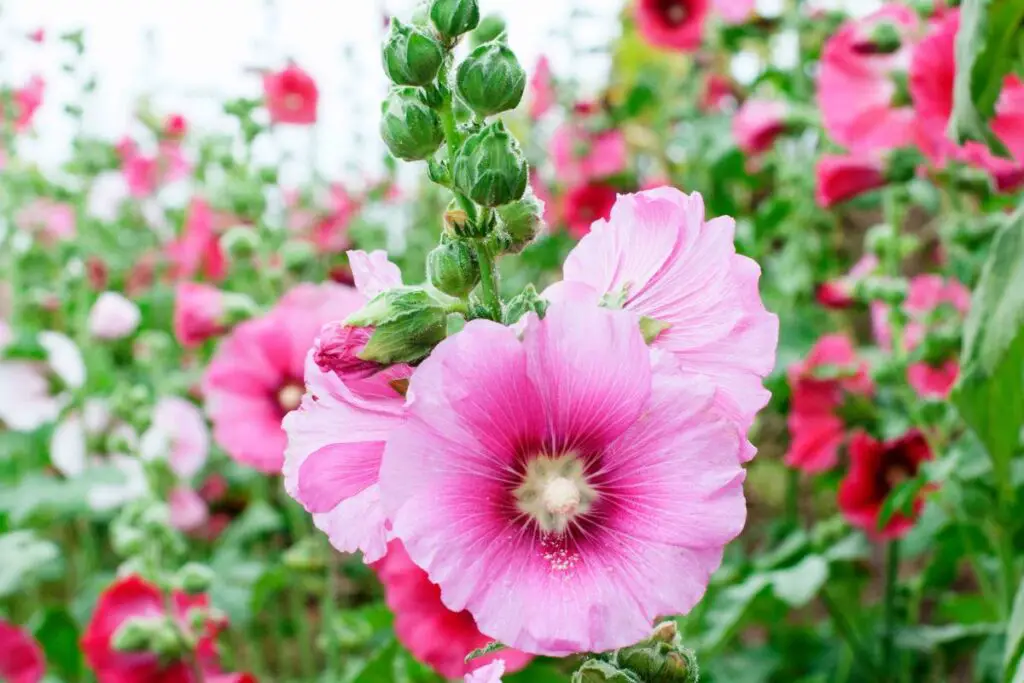
Hollyhock is a popular plant, and due to its height, it looks excellent on borders, near fences, etc. Its self-seeding habit will bring blooms every year. It is adaptable to many conditions and appreciates good airflow to prevent fungal diseases.
Sunlight: Hollyhock will be straight and happy in sunny locations. In shady areas, the plant may flop. Some shade is appreciated if the climate is too hot and dry.
Watering: Water hollyhock to keep the soil consistently moist and water it at the roots and not from the top. Allow the soil to dry halfway from the top before the next watering. Too much watering can become an issue, especially during winter. Established hollyhock is highly drought tolerant.
Fertilizer: Feed the hollyhock with organic flower food or a fish emulsion during the bloom period. You can also add organic matter during spring to fulfill its high nutrient needs. If the plant grows in fertile soil, the need for frequent fertilizing reduces to some extent. The plant may have yellow leaves and fewer flowers if its nutrient need is not fulfilled.
General care: Hollyhock evolves best in temperate areas. It can tolerate low temperatures as low as 5°F. Please keep it down to average humid regions.
Love lies bleeding
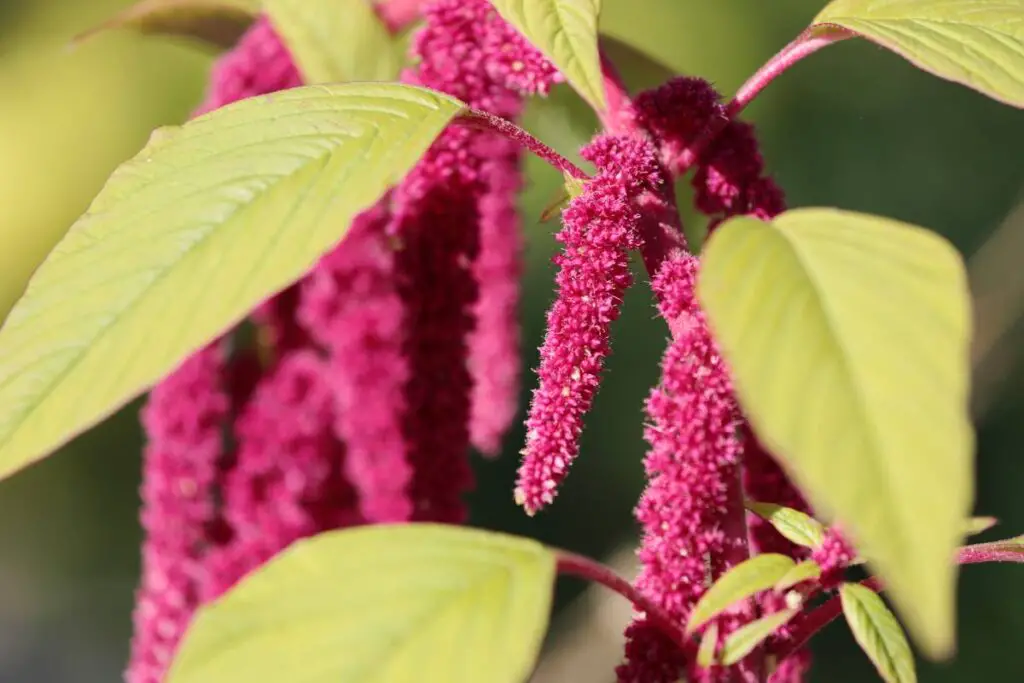
Love lies bleeding is the gardener’s favorite for its bright red, golden, and purple colored flowers and red or green foliage. It blooms in mid to late summer. Its beautiful colors will fill your garden beds or can be planted in borders. Its flowers also can be dried and added to flower arrangements.
Sunlight: Love lies bleeding and can be kept in full sun to part shade. Though they will develop best in full sun during intense hot temperatures, they would relish shade.
Watering: Water love lies bleeding is drought tolerant but enjoys good watering sessions. When grown from seeds, they appreciate regular watering until established. Matured ones will be happy with periodic watering.
Fertilizer: Add organic compost to love lies bleeding while planting. Feed the plant during the growing season with liquid fertilizer. The best time to feed them is before flowering to facilitate abundant flowering.
General care: Love lies bleeding and can withstand temperatures below 40°F. This plant is sensitive to frost; hence protection is required.
Calendula
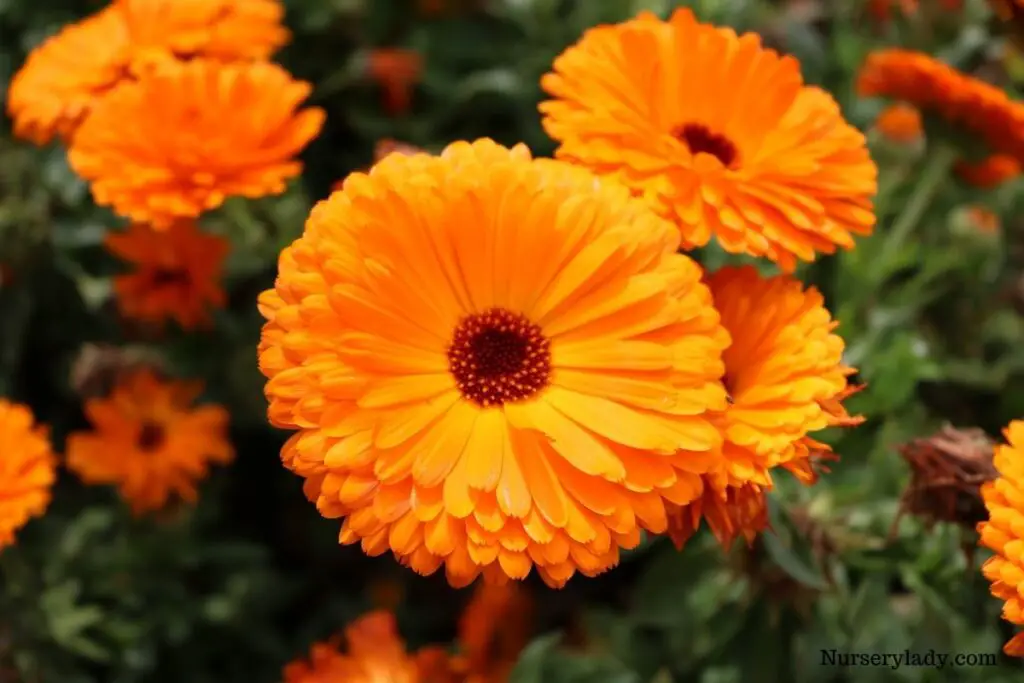
Calendula is popularly known as pot marigold due to its gold flowers. Its daisy-like appearance draws bees, butterflies, and other pollinators to the garden. It grows in high-speed flowering in six to eight weeks from seeding. It is easy growing and can be grown in gardens and containers.
Sunlight: Calendula is a sun-loving plant but not a fan of scorching temperatures. During such conditions, some shade is recommended.
Watering: Water calendula regularly to establish strong roots. It will flourish with occasional watering and may suffer with too much watering. Keeping the soil evenly moist is the best for the plant.
Fertilizer: Feeding is not essential once the plant is established. For plants growing in rich soil, no additional fertilizing is needed. If the soil medium is poor, applying well-balanced liquid fertilizer once in the spring is advised.
General care: Calendula enjoys mild temperatures and may decline in intense hot temperatures. Protect the plant from frost, and you can use a frost blanket overnight. Mulching also helps in saving the plant from cold. Deadhead shades bloom for flowering and pinch young plants for bushier growth.
Phlox
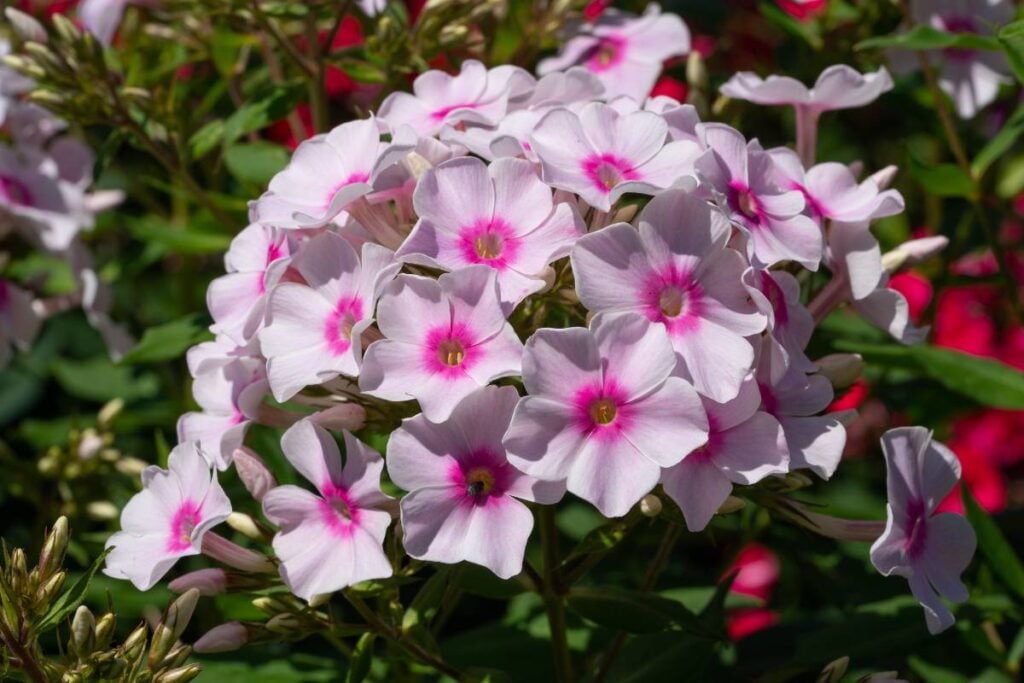
Phlox feature large blooms in a variety of colors. It attracts hummingbirds, butterflies, etc. It has sturdy stems that serve as beautiful cut flowers. With minimal care, this plant will revisit your garden year after year.
Sunlight: Phlox likes full sun, which gives the plant abundant blooms. In hot climates, some afternoon shade is preferred.
Watering: Water phlox to keep it evenly moist and never overwater it. Water at the roots and not from the top to avoid powdery mildew.
Fertilizer: Feed phlox with a well-balanced fertilizer once in the spring yearly. If the soil is moderately rich, little or no feeding is required.
General care: Phlox prefer a warm climate and dislike a hot and humid environment. Adding mulch will keep the roots cool in the hot weather. Remove spent flowers for continuous flowering.
Poppy
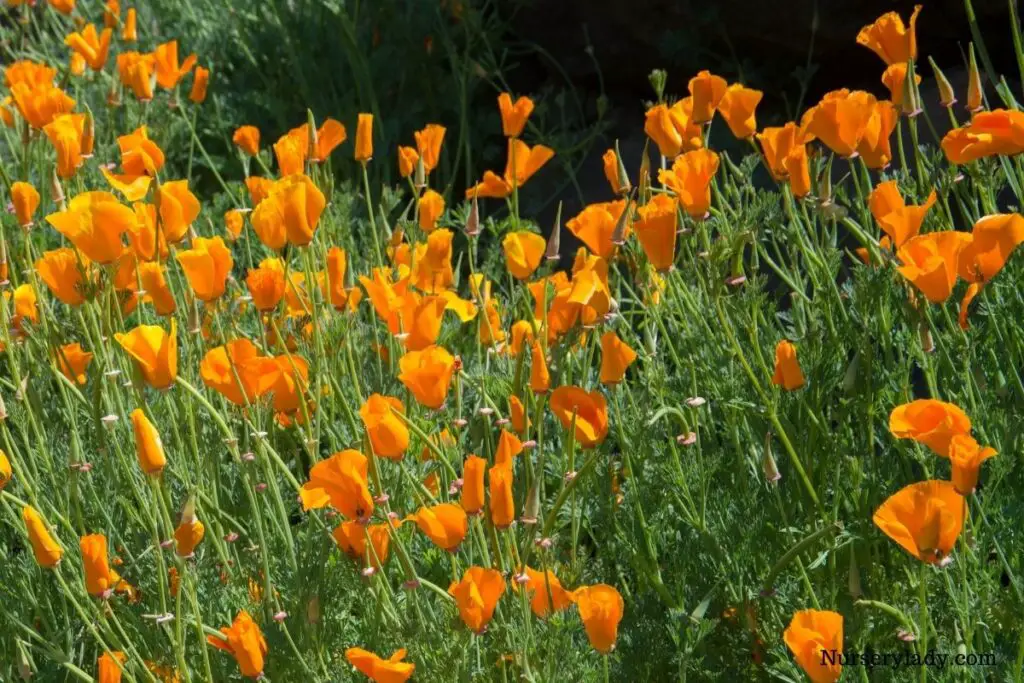
A Poppy is a graceful flower with multiple color options. You can add it to your garden beds, borders, or containers. It will keep blooming in adverse conditions too. It will stay in little care and is not very demanding. Also, its self-seeding quality gives you more such plants year after year.
Sunlight: Poppy develops satisfactorily in full sun. In low light, the plant may have fewer blooms. Look for the sunniest location to plant your poppies. It can also adapt to other lighting conditions but has slow growth and fewer flowers.
Watering: Water poppy while young to keep the soil moist. Once established, water only when the soil is dry. Excess watering may lead to leggy growth, overgrown stems, etc. During dry climates, supplemental watering serves as a relief to the plant.
Fertilizer: Poppy can grow without any feeding. However, finding fewer flowers but abundant foliage indicates a lack of phosphorus and an excess nitrogen ratio. Balance out by amending the soil with phosphorus-rich fertilizer.
General care: Poppy prefers warm temperatures and is not frost tolerant. It will germinate when the soil temperature is between 50°F to 60°F. If you want to extend its flowering period, keep deadheading its spent flowers.
Strawflowers
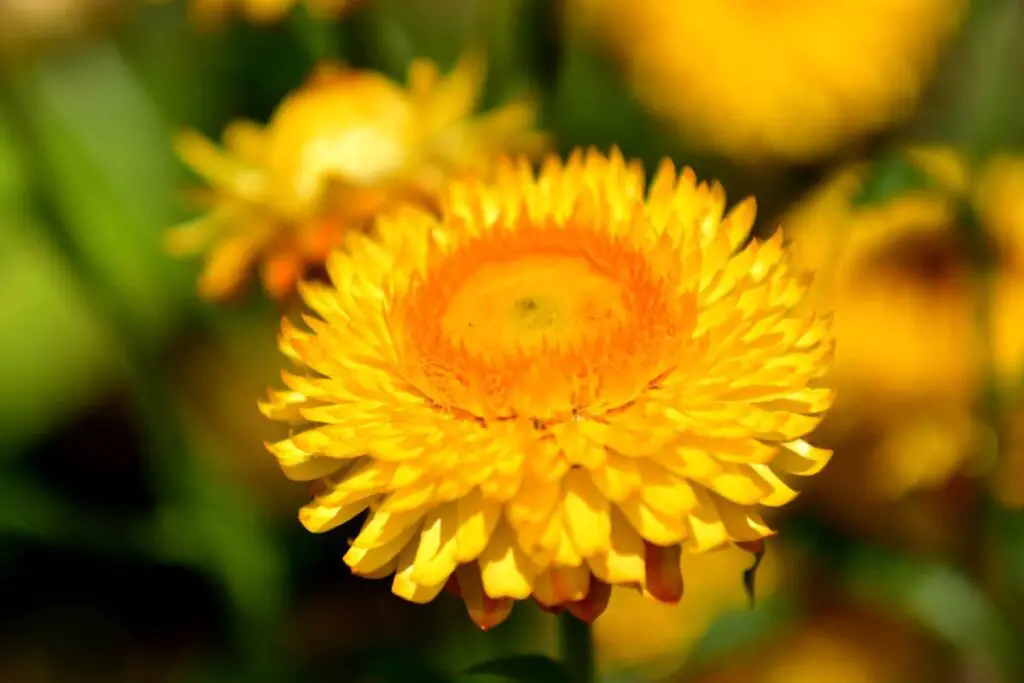
Strawflowers are simple-looking flowers resembling daisies in form, but the petals are paper-like. Its long sturdy stems may require staking where the new cultivars are stocky and don’t need support.
Light: Strawflowers like hot summers for their bright sun. Full sun will promote flowering and lead to solid stems that might not need stakes. They would grow in partial shade, but the blooming will be less.
Watering: Strawflowers are drought tolerant, but that doesn’t mean you keep them dry for long periods. Watering once a week will keep them fresh and wholesome. Do not let the water sit in the soil for extended periods, as it can promote fungus, root rot, etc.
Fertilizer: Feed strawflowers monthly with a portion of balanced flower food. For flowers growing in containers, increase the feeding frequency to about every two weeks. Follow instructions while feeding to avoid overdosage.
General care: Strawflowers prefer a temperature range between 65°F to 70°F during the day and 60°F at night. They are not tolerant to frost; hence protection is required. They grow best in warm climates and low humidity. Deadheading will prolong their bloom time.
Wishbone

Wishbone brings color and freshness to the shadier parts of your space. Its trumpet-shaped blooms come in various colors and flower in partial shades too. It rebels against deer and attracts pollinators like hummingbirds. With minimalistic care, it will keep growing without complaint. Planting it at the right time is crucial to produce a healthy plant.
Light: Wishbone evolves best in a location with morning and afternoon sun. If the sun is too intense, keep the plant under shade to protect it from harsh sunlight.
Watering: Wishbone appreciates frequent watering but not drowning. Keep the soil evenly moist and allow the soil to dry halfway before subsequent waterings.
Fertilizer: Wishbone will grow best when fed with a balanced fertilizer every few weeks during its growing period. A slow-release or liquid fertilizer works best when given in the proper dosage.
General care: Wishbone prefers temperatures ranging from 70°F to 75°F during the day and 65°F to 70°F at night time. It will be fine in cool weather but may suffer from frost. Mulching during hot summer helps retain moisture, keep roots cool, and maintain average humidity.
